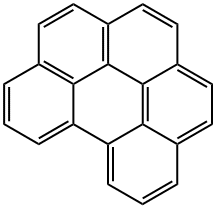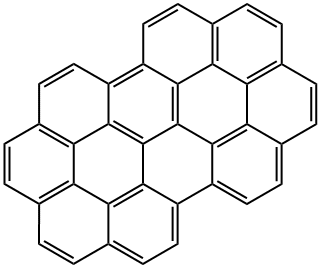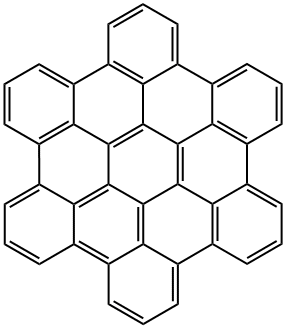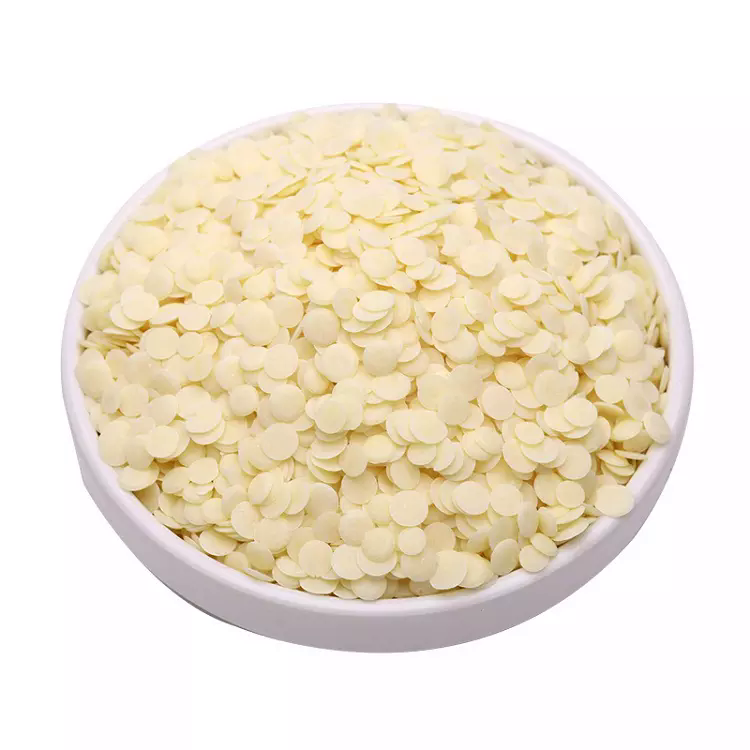1,12-BENZOPERYLENE
Synonym(s):1,12-Benzoperylene;Benzo[ghi]perylene solution
- CAS NO.:191-24-2
- Empirical Formula: C22H12
- Molecular Weight: 276.33
- MDL number: MFCD00004135
- EINECS: 205-883-8
- SAFETY DATA SHEET (SDS)
- Update Date: 2025-01-06 13:21:43

What is 1,12-BENZOPERYLENE?
Chemical properties
solid
The Uses of 1,12-BENZOPERYLENE
Research chemical. Derived from industrial and experimental coal gasification operations where the maximum concentration detected in coal tar streams was 2.7 mg/m3 (Cleland, 1981).
The Uses of 1,12-BENZOPERYLENE
An n-channel organic semiconductor.
Definition
ChEBI: Benzo[ghi]perylene is an ortho- and peri-fused polycyclic arene.
General Description
Colorless to white crystalline solid. Water insoluble.
Air & Water Reactions
Insoluble in water.
Reactivity Profile
Vigorous reactions, sometimes amounting to explosions, can result from the contact between aromatic hydrocarbons, such as 1,12-BENZOPERYLENE, and strong oxidizing agents. They can react exothermically with bases and with diazo compounds. Substitution at the benzene nucleus occurs by halogenation (acid catalyst), nitration, sulfonation, and the Friedel-Crafts reaction.
Health Hazard
Inhalation of material may be harmful. Contact may cause burns to skin and eyes. Inhalation of Asbestos dust may have a damaging effect on the lungs. Fire may produce irritating, corrosive and/or toxic gases. Some liquids produce vapors that may cause dizziness or suffocation. Runoff from fire control may cause pollution.
Health Hazard
There is very little information available inthe literature on the toxicity of this compound. Benzo[g,h,i]perylene has low oraltoxicity. On the basis of its structural similarities with other carcinogenic polynucleararomatics, this compound is expected to show carcinogenic properties. Such evidence, however, is inadequate at the moment. A histidinereversion–Ames test for mutagenicity gaveinconclusive results.
Fire Hazard
Some may burn but none ignite readily. Containers may explode when heated. Some may be transported hot.
Safety Profile
Questionable carcinogen.Mutation data reported. When heated to decomposition itemits acrid smoke and irritating fumes.
Carcinogenicity
Subcutaneous or dermal administration (repeated administration and initiation–promotion protocols) of benzo[ghi]perylene to mice gave negative results. Intrapulmonary injection into rats gave results considered to be inadequate for evaluation.
Source
Drinking water standard: No MCLGs or MCLs have been proposed (U.S. EPA, 2000).
Detected in 7 of 8 diesel fuels at concentrations ranging from 0.008 to 0.35 mg/L with a
mean value of 0.113 mg/L (Westerholm and Li, 1994). Identified in Kuwait and South Louisiana
crude oils at concentrations of <1 and 1.6 ppm, respectively (Pancirov and Brown, 1975) and in
fresh motor oil (120 μg/kg) and used motor oil (108.8–289.4 mg/kg) (quoted, Verschueren, 1983).
Detected in asphalt fumes at an average concentration of 22.76 ng/m3 (Wang et al., 2001).
The concentration of benzo[ghi]perylene in coal tar and the maximum concentration reported in
groundwater at a mid-Atlantic coal tar site were 1,200 and 0.002 mg/L, respectively (Mackay and
Gschwend, 2001). Based on laboratory analysis of 7 coal tar samples, benzo[ghi]perylene
concentrations ranged from ND to 1,900 ppm (EPRI, 1990). Benzo[ghi]perylene was reported in a
high-temperature coal tar pitch used in roofing at concentrations ranging from 754 to 3,980 mg/kg
(Malaiyandi et al., 1982).
Nine commercially available creosote samples contained benzo[ghi]perylene at concentrations
ranging from 1 to 45 mg/kg (Kohler et al., 2000).
Schauer et al. (2001) measured organic compound emission rates for volatile organic
compounds, gas-phase semi-volatile organic compounds, and particle-phase organic compounds
from the residential (fireplace) combustion of pine, oak, and eucalyptus. The particle-phase
emission rates of benzo[ghi]perylene were 0.437 mg/kg of pine burned and 0.173 mg/kg of
eucalyptus burned.
Gas-phase tailpipe emission rates from gasoline-powered automobiles with and without
catalytic converters were 0.26 and 10.7 μg/km, respectively (Schauer et al., 2002).
Environmental Fate
Biological. Based on aerobic soil die away test data at 10 to 30 °C, the estimated half-lives
ranged from 590 to 650 d (Coover and Sims, 1987).
Groundwater. Based on aerobic soil die away test data at 10 to 30 °C, the estimated half-lives
ranged from 3.23 to 3.56 yr (Coover and Sims, 1987).
Photolytic. The atmospheric half-life was estimated to range from 0.321 to 3.21 h (Atkinson,
1987). Behymer and Hites (1985) determined the effect of different substrates on the rate of
photooxidation of benzo[ghi]perylene using a rotary photoreactor. The photolytic half-lives of
benzo[ghi]perylene using silica gel, alumina, and fly ash were 7.0, 22, and 29 h, respectively.
Chemical/Physical. At influent concentrations of 1.0, 0.1, 0.01, and 0.001 mg/L, the GAC
adsorption capacities were 10.7, 4.6, 2.0, and 0.85 mg/g, respectively (Dobbs and Cohen, 1980).
Purification Methods
It forms light green crystals on recrystallisation from *C6H6 or xylene and sublimes at 320-340o/0.05mm [UV: Hopff & Schweizer Helv Chim Acta 42 2315 1959, Clar Chem Ber 65 846 1932, Fluoresc. Spectrum: Bowen & Brocklehurst J Chem Soc 3875 1954]. It also recrystallises from propan-1-ol [Altman & Ginsburg J Chem Soc 466 1959]. The 1,3,5-Trinitrobenzene complex has m 310-313o (deep red crystals from *C6H6), the picrate has m 267-270o (dark red crystals from *C6H6), and the styphnate (2,4,6-trinitroresorcinol complex) has m 234o (wine red crystals from *C6H6). [Beilstein 5 IV 2766.]
Properties of 1,12-BENZOPERYLENE
| Melting point: | 277-279 °C(lit.) |
| Boiling point: | >500 °C(lit.) |
| Density | 1.1847 (estimate) |
| vapor pressure | 1.10 (extrapolated from vapor pressures determined at higher temperatures, Pupp et al., 1974)1.04 (Murray et al., 1974) |
| refractive index | 1.9800 (estimate) |
| Flash point: | -18 °C |
| storage temp. | room temp |
| solubility | Soluble in most solvents (U.S. EPA, 1985) including benzene, methylene chloride, and acetone. |
| pka | >15 (Christensen et al., 1975) |
| form | Needle-Like Crystals or Crystalline Powder |
| color | Yellow |
| Water Solubility | 0.137ug/L(25 ºC) |
| BRN | 1913029 |
| Henry's Law Constant | 1.88, 2.66, 5.13, 5.33, 6.51, and 8.59 at 10.0, 20.0, 35.0, 40.1, 45.0, and 55.0 °C, respectively
(wetted-wall column, ten Hulscher et al., 1992) |
| Stability: | Stable. Combustible. Incompatible with strong oxidizing agents. |
| IARC | 3 (Vol. 92, Sup 7) 2010 |
| EPA Substance Registry System | Benzo[g,h,i]perylene (191-24-2) |
Safety information for 1,12-BENZOPERYLENE
| Signal word | Warning |
| Pictogram(s) |
 Environment GHS09 |
| GHS Hazard Statements |
H410:Hazardous to the aquatic environment, long-term hazard |
| Precautionary Statement Codes |
P273:Avoid release to the environment. P391:Collect spillage. Hazardous to the aquatic environment P501:Dispose of contents/container to..… |
Computed Descriptors for 1,12-BENZOPERYLENE
| InChIKey | GYFAGKUZYNFMBN-UHFFFAOYSA-N |
New Products
Tert-butyl bis(2-chloroethyl)carbamate (S)-3-Aminobutanenitrile hydrochloride N-Boc-D-alaninol N-BOC-D/L-ALANINOL N-octanoyl benzotriazole 4-Hydrazinobenzoic acid 3,4-Dibenzyloxybenzaldehyde Electrolytic Iron Powder 1,1’-CARBONYLDIIMIDAZOLE R-2-BENZYLOXY PROPIONIC ACID 4-HYDROXY BENZYL ALCOHOL 1,1’-CARBONYLDI (1,2-4 TRIAZOLE) S-2-CHLORO PROPIONIC ACID (2-Hydroxyphenyl)acetonitrile 4-Bromopyrazole 5-BROMO-2CYANO PYRIDINE 5,6-Dimethoxyindanone 5-broMo-2-chloro-N-cyclopentylpyriMidin-4-aMine 3-(2,4-Dimethoxybenzyl)dihydropyrimidine-2,4(1H,3H)-dione 6-Bromo-3-iodo-1-methyl-1H-indazole 4-Ethylbenzylamine N-(5-Amino-2-methylphenyl)acetamide 2-(BOC-Amino)4-picoline 1-(4-Methylphenylsulfonyl)-1H-1,2,3-benzotriazoleRelated products of tetrahydrofuran
![NAPHTHO[2,3-A]CORONENE](https://img.chemicalbook.in/CAS/GIF/190-74-9.gif)


![BISANTHENE (PHENANTHRENO[1,10,9,8-OPQRA])PERYLENE](https://img.chemicalbook.in/CAS/GIF/190-39-6.gif)

![DIBENZO[LMQRS]NAPHTHA[3,2,1,8,7-DEFGH]PHENANTHRO[3,4,5-YZAB]PYRANTHRENE](https://img.chemicalbook.in/CAS/GIF/362600-03-1.gif)
![DIBENZ[BC,KL]CORONENE](https://img.chemicalbook.in/CAS/GIF/190-55-6.gif)
![DIBENZO[A,J]CORONENE](https://img.chemicalbook.in/CAS/GIF/190-72-7.gif)
You may like
-
![191-24-2 Benzo[ghi]perylene 98%](https://img.chemicalbook.in//ProductImageIndia/2024-03/Raw/943d223f-1ddb-408c-9cb1-c5ffeada079f.png) 191-24-2 Benzo[ghi]perylene 98%View Details
191-24-2 Benzo[ghi]perylene 98%View Details
191-24-2 -
 191-24-2 98%View Details
191-24-2 98%View Details
191-24-2 -
![Benzo[ghi]perylene CAS 191-24-2](https://img.chemicalbook.in//Content/image/CP5.jpg) Benzo[ghi]perylene CAS 191-24-2View Details
Benzo[ghi]perylene CAS 191-24-2View Details
191-24-2 -
![Benzo[ghi]perylene CAS 191-24-2](https://img.chemicalbook.in//Content/image/CP5.jpg) Benzo[ghi]perylene CAS 191-24-2View Details
Benzo[ghi]perylene CAS 191-24-2View Details
191-24-2 -
![Benzo[ghi]perylene CAS 191-24-2](https://img.chemicalbook.in//Content/image/CP5.jpg) Benzo[ghi]perylene CAS 191-24-2View Details
Benzo[ghi]perylene CAS 191-24-2View Details
191-24-2 -
![Benzo[ghi]perylene CAS 191-24-2](https://img.chemicalbook.in//Content/image/CP5.jpg) Benzo[ghi]perylene CAS 191-24-2View Details
Benzo[ghi]perylene CAS 191-24-2View Details
191-24-2 -
 100-71-0 99%View Details
100-71-0 99%View Details
100-71-0 -
 1446013-08-6 98%View Details
1446013-08-6 98%View Details
1446013-08-6